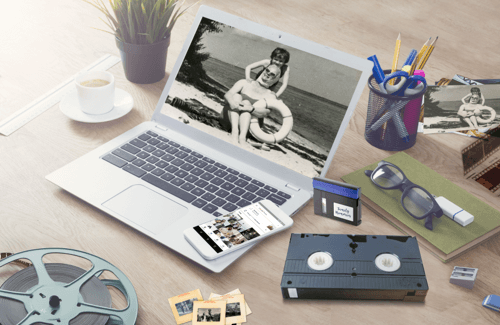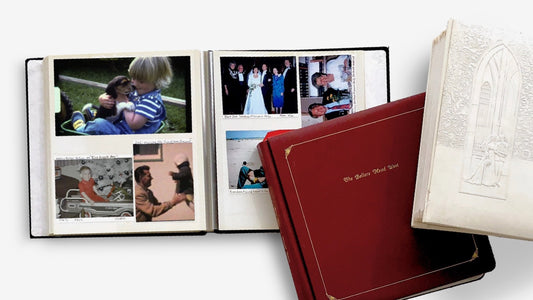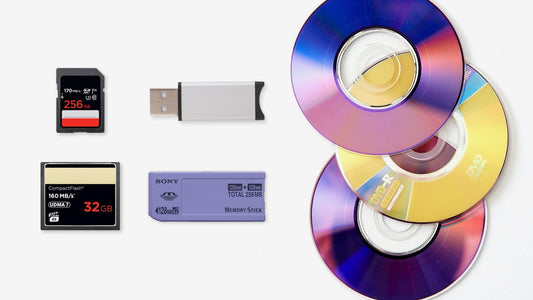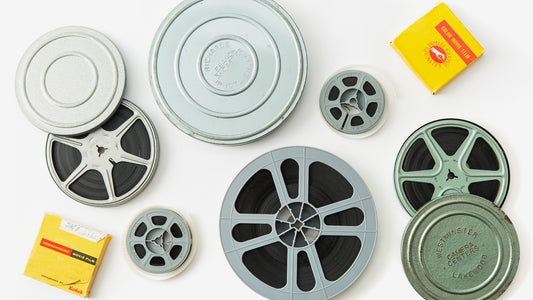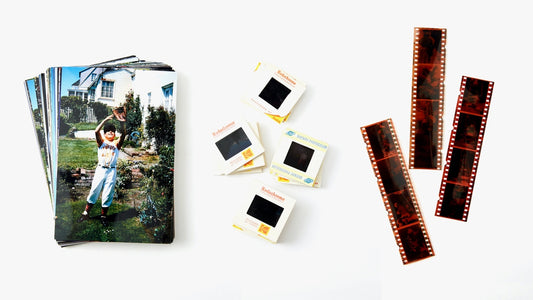If you’ve ever inherited a box of family photos, you know the mix of joy and responsibility that comes with it. Suddenly, you’re the keeper of your family’s visual history. The big question is, what’s the next step? Leaving them in that old cardboard box or sticky-paged album is a recipe for disaster. This is where learning how to store old photos becomes so important. It’s not just about organization; it’s about active preservation. In this article, we’ll break down the process into simple, actionable steps, from choosing acid-free materials to finding the perfect spot in your home, ensuring your memories are protected for generations to come.
Key Takeaways
- Use Archival Supplies in a Stable Location: Protect your photos for the long haul by using acid-free boxes and sleeves. Store them in a climate-controlled spot inside your home, like a bedroom closet, to shield them from damaging temperature and humidity swings.
- Handle Prints Gently and Label with a Pencil: The natural oils on your hands can leave permanent smudges, so always handle photos by their edges or wear cotton gloves. To add names and dates, use a soft pencil on the back to prevent ink from bleeding through and ruining the image.
- Create a Digital Backup for Peace of Mind: Digitizing your collection is the best way to safeguard your memories against unexpected damage like fire, floods, or fading. It also makes it incredibly easy to share your family’s history and enjoy your photos without risking the fragile originals.
Choose the Right Supplies for Storing Photos
Before you find the perfect spot for your photos, you need to make sure they’re housed in the right materials. Using the wrong supplies can do more harm than good, causing your precious memories to fade, yellow, or stick together. Think of it like packing away a treasured wedding dress—you wouldn't just toss it in a cardboard box. Your photos deserve the same level of care. Investing in archival-quality storage is one of the best things you can do to protect your prints for the long haul.
Acid-Free Boxes and Binders
The most important rule of photo storage is to go acid-free. Everyday cardboard boxes and paper products contain acids that can leach into your photos over time, causing them to become brittle and discolored. Instead, look for boxes, albums, and binders specifically labeled as "archival-quality." These containers are made from materials that have a neutral pH, meaning they won’t break down and damage your photos. They create a safe, stable environment that acts as the first line of defense against dust, light, and pests.
Archival Sleeves and Envelopes
For an extra layer of protection, it’s a great idea to place individual photos in archival sleeves or envelopes before putting them in a box. This prevents them from rubbing against each other, which can scratch the image surface. Clear sleeves made from polypropylene, polyester, or polyethylene are a fantastic option because you can see the photo without having to handle it directly. If you prefer envelopes, make sure they are also acid-free. This simple step keeps each print isolated and safe from fingerprints, spills, and the kind of accidental damage that can happen when sorting through a loose stack of photos.
Lignin-Free Paper Inserts
Here’s a term you might not be familiar with: lignin. Lignin is a natural compound in wood pulp that causes paper to become yellow and acidic as it ages—it’s the reason old newspapers look the way they do. When you’re shopping for archival supplies, you’ll want to make sure they are both acid-free and lignin-free. If you’re stacking photos within a box, placing a sheet of lignin-free paper or cardstock between each print can prevent any potential chemical transfer, especially if you have photos with information written on the back.
What to Avoid: Common Household Items
Just as important as knowing what to use is knowing what to avoid. Many common household items can cause irreversible damage to your photos. Steer clear of rubber bands, which can dry out, get sticky, and fuse to your prints. Paper clips can rust and leave indentations. And definitely avoid albums with "magnetic" pages and sticky plastic film—the adhesive on these pages is highly acidic and can permanently ruin your photos. Regular plastic bags and containers can also trap moisture and release harmful chemicals, so it’s best to avoid those materials and stick to supplies designed for photo preservation.
Create the Perfect Environment for Your Photos
You’ve found the perfect acid-free boxes and archival sleeves, but your work isn’t done just yet. Where you store those boxes is just as critical as what’s inside them. Think of it like finding the perfect home for your memories—it needs to be safe, stable, and comfortable. Creating the right environment will protect your photos from the elements and ensure they stay in great condition for years to come, giving you peace of mind. The goal is to find a spot that is cool, dry, and dark, away from the dramatic environmental shifts that can happen elsewhere in your home.
Control Temperature and Humidity
Photos are a bit like people—they don't appreciate extreme temperatures or wild humidity swings. The key to their long-term happiness is consistency. Aim to keep your storage area around 68°F with a humidity level between 35% and 55%. This sweet spot helps prevent the delicate emulsion from cracking, fading, or growing mold. You don't need a fancy climate-controlled vault; a closet in the main part of your house often provides the kind of stable environment that keeps your photos looking their best for generations.
Where to Store Photos (and Where Not To)
Let's talk about location. The absolute worst places to store your precious photos are attics, basements, and garages. These areas are notorious for dramatic shifts in temperature and humidity, which can wreak havoc on your collection. Instead, choose a spot inside your main living space. A shelf in a spare bedroom closet or a cabinet in your office are great options because they're typically climate-controlled. An added bonus? Keeping them accessible means you're more likely to pull them out and enjoy them. For ultimate accessibility, consider a photo transfer to have digital copies on hand anytime.
How the Wrong Environment Damages Photos
So, what actually happens when photos are stored in a damp basement or a hot attic? The damage can be heartbreaking and often irreversible. High humidity can cause photos to stick together, permanently fusing them into a single block. It also invites mold and mildew, which can eat away at the image. Temperature fluctuations can make photos brittle, warped, or curled. Colors can fade, turning vibrant memories into washed-out scenes. Protecting your photos is your best defense against this decay, and services like album scanning can create a permanent digital backup before any damage occurs.
How to Organize Your Photos Before Storing Them
Before you even think about archival boxes or temperature control, it’s time for the most important—and often most enjoyable—part of the process: organizing your photos. Taking the time to sort through your collection now will make it so much easier to find that one specific photo of your grandma’s famous apple pie or your dad’s questionable 70s haircut. A little organization goes a long way, ensuring your memories are not just preserved, but also accessible. Plus, if you ever decide to create a beautiful digital archive, having everything in order makes the photo transfer process a breeze. So, put on some music, grab a snack, and get ready to take a wonderful trip down memory lane.
Sort and Categorize Your Collection
First things first, you need to figure out what you have. Go through your photos and create three simple piles: keep, toss, and doubles. The "toss" pile is for blurry, out-of-focus shots or photos where you can’t quite tell what’s happening. For the "doubles," consider offering them to family members or friends who might be in the pictures. Once you have your "keep" pile, you can start categorizing. You might organize them chronologically by year, by event (like holidays, vacations, and birthdays), or by person. There’s no right or wrong way—just choose a system that makes sense to you and will help you find what you’re looking for later.
Label Photos Without Damaging Them
Adding context to your photos is a gift to your future self and your family, but it’s crucial to do it safely. The golden rule is to always use a soft-lead pencil, like a standard No. 2, to gently write on the back of your prints. Ink from pens can bleed through over time, fade, or even react with the chemicals in the photograph, causing permanent damage. When you label your photos, stick to the essentials: who is in the picture, the date it was taken, and the location or event. Write lightly along the border on the back to avoid creating indentations that could show through on the front of the image.
Create a Simple Photo Inventory
For your most treasured photos, consider creating a simple inventory. This doesn’t have to be complicated. You can use acid-free notecards or a separate notebook to jot down more detailed information. For each photo or group of photos, write down the year, the people in it, and any special stories or memories associated with that day. This extra step adds so much richness and helps preserve the stories that a single image can’t always tell on its own. Think of it as creating a guide for future generations, so they’ll know not just who is in the photo, but why that moment was so special.
How to Handle Old Photos Safely
Before you place your photos in their new archival homes, it’s crucial to handle them correctly. Every touch leaves a mark, and years of casual handling can cause irreversible damage. Think of your old photos as delicate artifacts—because they are! Taking a few simple precautions when sorting, cleaning, and labeling your collection will ensure they stay in the best possible condition for years to come. It’s a small effort that makes a huge difference in preserving the moments you cherish most.
Handle with Care: When to Use Gloves
Your hands contain natural oils, lotions, and dirt that can permanently damage the delicate surface of a photograph, leaving behind fingerprints and smudges that worsen over time. The best way to protect your pictures is to create a barrier. As professional archivists recommend, you should "always wear natural, powder-free gloves when handling photos." White cotton or nitrile gloves work perfectly. If you find yourself in a pinch without gloves, be sure to wash and dry your hands thoroughly and only handle the photos by their absolute edges. This simple step is one of the most effective ways to protect your memories from accidental damage.
Gently Clean Your Photos
Over the years, photos can collect a layer of dust and debris. While it’s tempting to wipe them clean, using the wrong materials can scratch the surface or damage the emulsion. It's important to use special methods to avoid causing more harm. For loose dust, a gentle approach is best. You can use a soft, clean camel hair brush to lightly sweep debris away from the photo’s surface. A can of compressed air, held at a safe distance, can also work wonders. Never use water, household cleaners, or a rough cloth, as these can cause the image to fade, streak, or even peel away. If a photo is particularly fragile or stained, it’s often safer to leave it as is and consider a professional photo transfer service to create a clean digital copy.
The Right Way to Write on Photos
It’s completely understandable to want to jot down names, dates, and places on the back of your photos. This context is part of the memory! However, your choice of writing tool matters immensely. Ink from ballpoint or felt-tip pens can bleed through the paper over time, creating permanent marks on the image itself. To safely label your pictures, "always use a pencil (like a regular No. 2 pencil) instead of a pen." The graphite is stable and won’t damage the photo. When you write, use light pressure and stick to the back of the photo, preferably along the border. An even safer option is to place the photo in an archival sleeve and write the information on the sleeve itself.
Should You Digitize Your Old Photos?
After carefully organizing and storing your physical photos, you might think the job is done. But there’s one more crucial step to consider for true peace of mind: creating digital copies. Think of it as the ultimate insurance policy for your most precious memories. While proper physical storage is essential for preserving the original prints, digitizing your collection protects them from the unexpected, like water damage, fire, or simply the slow fade of time.
Creating a digital archive also makes your memories more accessible than ever. Instead of being tucked away in a box, your favorite moments can be easily shared with family across the country, used to create beautiful photo books, or enjoyed in a digital frame on your mantel. It brings your history into your daily life. Whether you decide to tackle the project yourself or use a professional photo transfer service, digitizing is a powerful way to safeguard and celebrate your family’s story for generations to come.
Why Digitizing Your Photos Is a Good Idea
Making digital copies is one of the single best things you can do to preserve your family records. If something were to happen to the original photos, you’ll still have the digital version to cherish and reprint. This backup is invaluable, protecting your legacy from accidents and deterioration. It also makes sharing a breeze. Imagine sending a forgotten photo of your grandparents to your entire family with just a few clicks—no more worrying about mailing a one-of-a-kind print. Digitizing also helps you get more organized, allowing you to sort photos by date, event, or person on your computer, making it simple to find exactly what you’re looking for.
DIY Scanning: What You'll Need
If you’re feeling crafty and have some time, you can certainly scan your photos at home. To get good results, you’ll need a flatbed scanner. Models like the Epson V600 are popular for home use because they can handle photos, slides, and negatives. The process involves carefully placing each photo on the scanner, choosing the right resolution (600 DPI is a great starting point for prints), and saving the file. It can be a time-consuming project, especially for large collections or delicate photo albums, but many people find it to be a rewarding trip down memory lane. Just be sure to work in a clean, dust-free area to get the best possible scans.
How to Store and Back Up Digital Copies
Once your photos are scanned, you need a solid plan for storing the digital files. Don’t just leave them on your computer’s desktop! A good rule of thumb is the 3-2-1 backup strategy: keep at least three copies of your files, on two different types of media, with one copy stored off-site. For example, you could save your photos on your computer’s hard drive, back them up to an external hard drive, and also upload them to a cloud storage service like Google Photos or Dropbox. This ensures that even if one copy is lost, you have others to rely on. And remember, technology changes, so while digital copies are fantastic, always hold on to your original prints.
Protect Your Photos From Common Damage
Your old photos have survived for decades, but they're still vulnerable to damage from light, chemicals, and poor storage conditions. The good news is that you can prevent most of this damage by being mindful of a few key things. Protecting your physical photos means thinking about where they live, what they touch, and how they're handled. A little bit of care now goes a long way in making sure these irreplaceable memories are around for future generations to enjoy. Let’s walk through the most common culprits of photo damage and the simple steps you can take to keep your collection safe.
Prevent Fading and Discoloration
Think of sunlight as the number one enemy of your colorful photos. Direct exposure to UV light, even for short periods, can cause vibrant colors to fade and the paper to become brittle. Your goal is to find a storage spot that’s cool, dry, and dark. An interior closet in a climate-controlled part of your home is a much better choice than a sunny bookshelf. For the best results, aim for a stable temperature around 68°F and a relative humidity between 35-55%. This controlled environment helps prevent the chemical reactions that lead to fading and yellowing, keeping your photos looking their best for years to come.
Steer Clear of Harmful Glues and Tapes
It can be tempting to grab the nearest roll of tape or glue stick to mend a torn photo or create a scrapbook, but please don't! Most household adhesives contain acids that will eat away at your photos over time, causing permanent stains and deterioration. The same goes for many photo albums from the past, especially the "magnetic" kind with sticky pages. Instead, look for supplies that are specifically labeled as archival-safe or acid-free. Using photo corners or polypropylene sleeves is a much safer way to organize and display your pictures without causing irreversible harm to the original prints.
Avoid These Common Storage Mistakes
Where you store your photos is just as important as what you store them in. Attics and basements are two of the worst places for your collection because they experience extreme temperature and humidity swings, and they're often the first places to flood. Another common mistake is laminating old photos. While it seems like a good way to protect them, the heat and adhesive can permanently damage the delicate image. The single best way to protect your memories from all physical threats—from fading to floods—is to create a digital copy. A professional photo transfer service creates a high-quality backup that you can easily share and enjoy without risking the fragile originals.
Create Your Long-Term Photo Preservation Plan
Properly storing your photos isn't a one-and-done task; it's an ongoing commitment to protecting your family’s history. Creating a long-term preservation plan sounds intimidating, but it’s really just about establishing a few good habits. The goal is to use special methods and materials to store your photos, negatives, and documents to stop them from getting more damaged over time. This means using the right archival boxes and sleeves and keeping your collection in a stable, climate-controlled environment away from attics and basements.
Think of your plan as a simple framework for how you’ll handle your photos now and in the future. It ensures that as you uncover more memories—like that box of slides in your parents' attic—you have a system ready to go. A key part of any modern preservation plan is creating a digital backup. Having a digital copy is the best insurance against unexpected damage from floods, fires, or simple decay. Services that offer photo transfer can create high-quality digital versions of your prints, slides, and negatives, giving you peace of mind and an easy way to share your memories with family. This digital archive becomes a permanent, accessible part of your family's legacy that won't fade or tear.
Set a Schedule for Regular Check-ins
Once your photos are safely stored, it’s a good idea to check on them periodically. You don’t need to do this every week, but setting a reminder to peek in on them once or twice a year can prevent small issues from becoming big problems. The most important thing is that the temperature and humidity in your storage area stay consistent, as big changes can cause a lot of damage.
Make it a habit to check your collection when you do other annual tasks, like changing the batteries in your smoke detectors. During your check-in, look for any signs of trouble: a musty smell, dampness, brittle or curling photos, or evidence of pests. Catching these issues early gives you the best chance to save your precious memories.
Build a Simple Preservation Routine
To avoid feeling overwhelmed, create a simple, repeatable routine for organizing your photos. When you have a box of loose pictures, start by sorting them into three piles: keep, toss, and doubles. You can get rid of photos you don't want or offer extra copies to family members. For the photos you’re keeping, place them in archival-quality sleeves or between sheets of acid-free paper inside a designated photo box. This routine makes the process manageable. If you come across entire photo albums, consider an album scanning service to digitize the pages exactly as they are, preserving the original context and any handwritten notes.
Related Articles
- Organizing Digital Memories: A Step-by-Step Guide
- Archiving Old Photos: A Complete Guide
- Best Storage Solutions for Old Photos
- Photo Preservation Tips: How to Keep Your Memories Safe
Frequently Asked Questions
What's the first thing I should do if I have a huge, unorganized box of photos? Don't let the size of the project stop you before you start. The best first step is to simply sort your photos into three piles: keep, toss, and doubles. The "toss" pile is for photos that are blurry or beyond recognition. For the doubles, you can set them aside to give to family. This initial sort makes the collection feel much more manageable and gives you a clear idea of what you're working with before you move on to organizing and storing the keepers.
Are those old sticky photo albums from the 70s and 80s really that bad for my pictures? Yes, they unfortunately are. Those "magnetic" albums use a highly acidic adhesive on the pages that can cause serious, irreversible damage over time. The chemicals in the glue can leach into your photos, causing them to turn yellow, become brittle, and permanently stick to the plastic overlay. If your photos are in these albums, it's a great idea to carefully remove them and place them in archival-safe sleeves or boxes.
Can I just use regular plastic tubs from the store for storage? While a plastic tub is better than leaving photos exposed in a damp basement, it's not an ideal long-term solution. Many household plastics can release chemical fumes over time that can harm your photos. They can also trap moisture, which creates a perfect environment for mold to grow and for photos to stick together. Your best bet is to invest in boxes specifically labeled as "acid-free" and "archival-quality" to create a stable environment for your prints.
What should I do if some of my photos are already faded or stuck together? If your photos are already damaged, the most important thing is to prevent further harm. For photos that are stuck together, resist the urge to pull them apart, as this can tear the image surface completely. The safest course of action is to create a high-quality digital copy of the photo as it is. Digitizing preserves the image before any more fading or deterioration can occur and gives you a clean version you can reprint and share.
Is it worth the effort to digitize my photos if I'm already storing them properly? Absolutely. Think of digitization as the ultimate insurance policy for your memories. Even with perfect archival storage, your physical photos are still vulnerable to unexpected disasters like a fire or flood. Creating a digital backup ensures your family's history is safe no matter what happens. It also makes your photos much more accessible, allowing you to easily share them with loved ones and enjoy them without having to handle the fragile originals.





